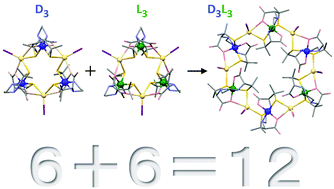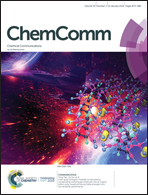Conversion of 12-membered d3- and l3-Co III3Cd II3 metallorings into a 24-membered d3l3-Co III6Cd II6 metalloring†
Abstract
The treatment of [Co(D- or L-ebp)]− with CdX2 (X = Br−, I−) gave a cyclic CoIII3CdII3 complex with a 12-membered metalloring, [Cd3X3{Co(D- or L-ebp)}3] (D3- or L3-1X). The use of a 1 : 1 mixture of [Co(D-ebp)]− and [Co(L-ebp)]−, instead of [Co(D- or L-ebp)]−, led to the creation of a cyclic CoIII6CdII6 complex with a 24-membered metalloring, [Cd6X6(H2O)6{Co(D-ebp)}3{Co(L-ebp)}3] (D3L3-2X). Compounds D3L3-2X were also produced when D3-1X and L3-1X were mixed in water in a 1 : 1 ratio, illustrating the conversion of a pair of homochiral metallorings into a double-sized heterochiral metalloring.



 Please wait while we load your content...
Please wait while we load your content...
